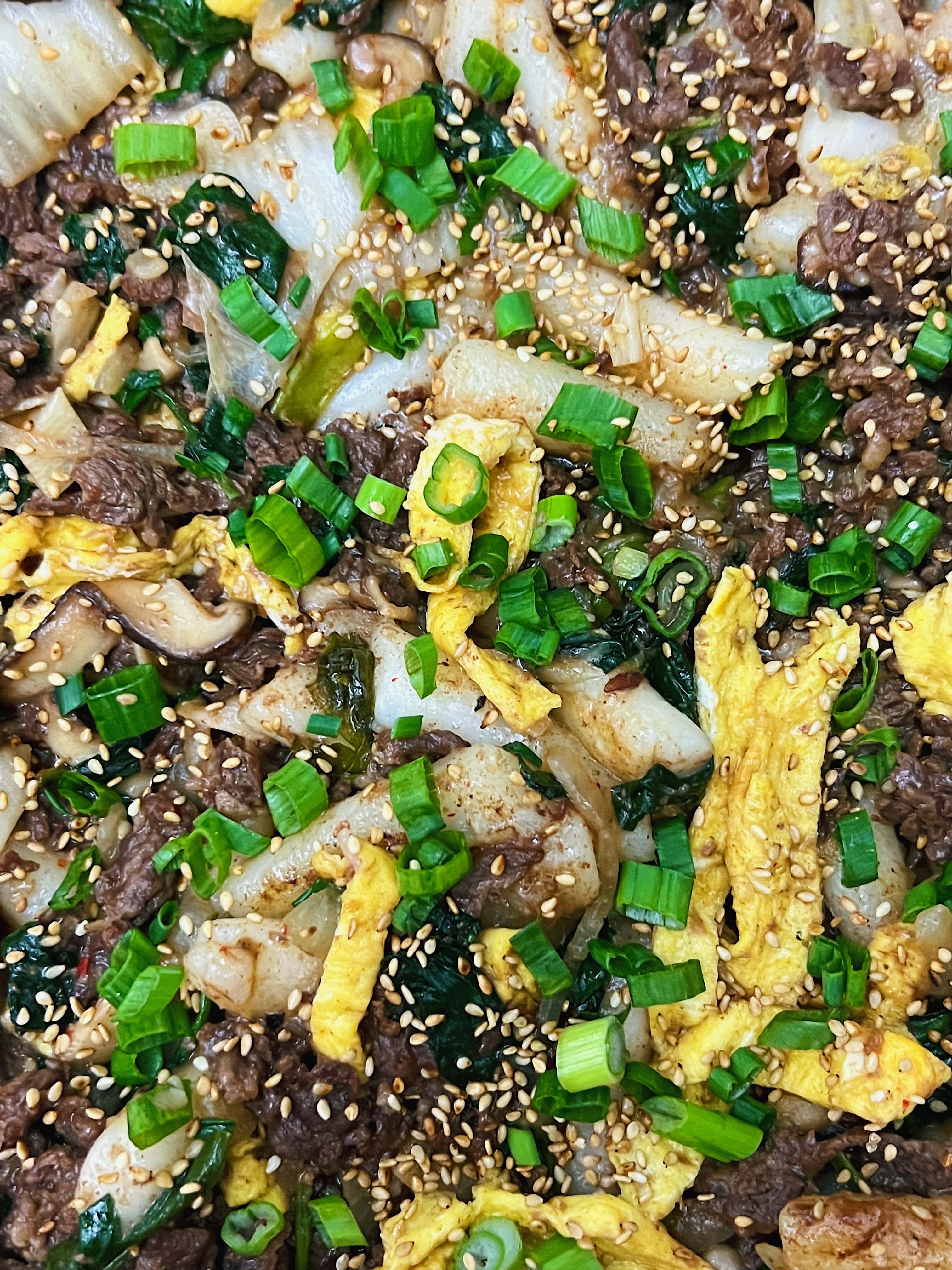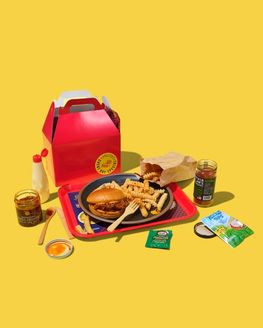Korean Rice Cakes with a Crispy Brown Butter Twist

When I was growing up, rice cakes were diet food. They were the bland, styrofoam-textured “snacks” that were popular in the ‘90s for those trying to watch their figure, and something I begrudgingly ate a lot of being a fat kid (and teen and tween and adult), even though they had the texture of packing peanuts.
Then I discovered that rice cakes could be much more than those fluffy hockey pucks when I first tried Korean tteokbokki. I am a Korean American adoptee, raised by white parents in Binghamton, NY, so I didn’t grow up with tteok around the house. I didn’t use little coin-shaped rice cakes—which, by the way, are made of steamed rice flour and are almost always gluten-free—for good luck New Year’s Day soup. I first tried tteokbokki in my early years in New York City, where I lived for a decade. I was at some Korean BBQ restaurant and the little rice cakes swimming in a vibrant red sauce caught my eye. I attempted to pick one up with chopsticks, but it was slippery. After a few tries—and maybe a stab—I took a bite and my eyes immediately watered from the spice. But the garlic-forward flavor, the slight sweetness of the gochujang, and, above all else, the satisfyingly chewy texture, brought me back for a few more bites.
Through the years following, I experimented with different types of tteokbokki. I’ve made Maangchi’s Royal Court Tteokbokki many times, which is a savory and not-spicy-at-all version that Korean royalty ate during the Joseon dynasty. I also riffed on the Korean street food with my recipe for Grilled Cheese Tteokbokki, which calls for cooking rice cakes in ghee until crispy and topping with mozzarella cheese and a drizzle of sweetened condensed milk. I’ve made a breakfast version with crumbled sausage, scrambled eggs, and American cheese; made tteok and cheese with cut-up hot dogs for Korean-American nostalgia; and even topped the rice cakes with bolognese sauce. The possibilities are endless.
For this recipe, I decided to make my version of my favorite Korean BBQ marinade: bulgogi (marinated ribeye, sirloin, or sometimes even pork). I pulled from Maangchi, my friend Frances’ mom’s recipe, and notes from my tinkering to find the best ratios of salty and sweet. There is actually as much meat as there are rice cakes in this recipe so it could be a hearty main dish, not a side. Because the rice cakes are crisped in brown butter, similar to pan-fried gnocchi, they are a bit rich. Kimchi (and a little of its brine to deglaze the pan) adds a bit of spice to cut through that richness, but it mellows out in the cooking process so it’s more like cooked crunchy cabbage.
While developing this recipe, I ate this for a week straight and did not get sick of it. So I feel confident in saying run, don't walk to your local Asian market—I’m an H Mart stan—and grab some pre-sliced bulgogi meat, a big bag of rice cakes, and make this your new go-to weeknight meal. Or make it for friends and family, or serve a big platter at your next party. Whatever you do, just don’t make it with sad styrofoam rice cakes.

Brown Butter Bulgogi Tteokbokki
Serves: 4-6
Prep Time: 10 minutes
Total Time: 2 hours, 45 minutes (including minimum marinating time)
Ingredients
For the bulgogi marinade:
½ medium onion
¼ Asian pear, peeled
3 large cloves garlic
⅓ cup soy sauce
⅓ cup sake
3 tablespoons mirin
1 ½ tablespoons toasted sesame oil
1 ½ tablespoons sugar
1 pound (16 ounces) thinly sliced rib-eye or shaved beef
For the bulgogi tteokbokki:
1 pound garatteok (cylinder-shaped Korean rice cakes)
3 tablespoons neutral oil (such as canola), divided
2 eggs
Kosher salt
2 tablespoons unsalted butter
½ medium onion, thinly sliced (about 4 ounces)
6 scallions, white and light-green parts cut into 2-inch lengths and dark-green tops thinly sliced
6 ounces shiitake mushrooms, stemmed and sliced
4 cloves garlic, thinly sliced
5 ounces kimchi, chopped (about ½ cup), plus about 1 tablespoon kimchi brine
4 ounces baby spinach
Toasted sesame oil, for drizzling
Toasted sesame seeds, for garnishing

Directions
Marinate the bulgogi: Cut the onion and Asian pear into large chunks and add to a food processor or blender. Add the garlic, then blitz until smooth. Add the soy sauce, sake, mirin, sesame oil, and sugar and blend until combined. (Alternatively, you can grate the onion, pear, and garlic by hand into a bowl then mix in the rest of the ingredients.) Add the beef to a large bowl, pour over the marinade, and stir with a spatula or mix with your hands. Cover and let it sit in the fridge for at least 2 hours and up to 24 for maximum flavor infusion.
Soak the rice cakes: If your rice cakes are frozen, thaw in a bowl of cold water for 15 minutes. If they are thawed, add to a bowl, add enough water to cover (about 1 cup), and microwave for 5 minutes. This will help them soften without getting soggy—and without needing to boil a separate pot of water! Drain the rice cakes thoroughly and set aside.
Make the egg ribbons: Preheat a medium (8- or 10-inch) skillet, preferably nonstick, over medium heat for 2 minutes. Add ½ tablespoon of neutral oil and tilt the pan so it coats the bottom. Lightly beat the eggs with a hefty pinch of kosher salt. Add to the skillet, tilting and swirling the pan until the eggs evenly coat the bottom like a crepe. Cook for 2 minutes, using a spatula to push the cooked egg toward the center and tilting the pan to let the uncooked egg fill that spot. Slide the eggs out onto a cutting board (they will look a little runny, but the residual heat will finish cooking them), roll them up into a log, and let cool for about 5 minutes. (You can also flip it, but it can be a little difficult and not necessary!) Slice the log into thin ribbons.
Make the bulgogi tteokbokki: Preheat a large skillet or wok over medium heat for about 3 minutes. Add the butter and cook until it smells nutty and you see brown specks start to form, about 2–4 minutes. Add the rice cakes and cook, turning occasionally, until lightly golden on the outside, 5–7 minutes. (If your rice cakes clump together as they cook, gently separate them and toss in the brown butter so it coats every piece.) Remove from the pan and set aside.
To the same pan, add 2 tablespoons of neutral oil, the onion, and the white and light-green parts of the scallions. Cook until translucent, about 4 minutes. Add another tablespoon of oil and the mushrooms; cook, stirring often, until tender and starting to caramelize, 4 minutes. Add the garlic and cook for 1 minute, then add the kimchi and brine and cook for 2 minutes, snipping any larger leaves into smaller pieces with kitchen shears. (You can also pre-chop the kimchi with a knife before starting the cooking process.)
Using a slotted spoon or your hands, remove the bulgogi from the marinade and transfer directly to the pan. (No need to drain the excess marinade off the meat, as this will help make a sauce later; be careful, it can splatter a bit!) Increase the heat to medium-high and cook until the marinade comes to a boil and the meat is cooked through, 5 minutes. (If using pre-sliced beef, cut into smaller, bite-sized pieces with kitchen shears directly in the pan once the meat is partially cooked.) It will brown slightly and get tender but not very caramelized, and that’s okay.
Add the spinach and let it wilt. Add the reserved rice cakes and mushroom mixture, and half each of the egg ribbons and dark-green scallion tops. Stir together until the sauce coats everything in the pan. Add a hefty drizzle of sesame oil and a sprinkle of sesame seeds. Transfer to a large platter or serving bowl and garnish with the remaining egg ribbons, scallion tops, and more sesame seeds.
About Alyse Whitney:

Alyse Whitney is a Los Angeles-based food editor, recipe developer, and video host. She is a Korean-American adoptee who is currently tackling making homemade kimchi for the first time, and she's most passionate about karaoke, dips, and her dog, Miso (who eats out of East Fork breakfast bowls). Currently, she is a contributing editor at Cravings by Chrissy Teigen—where she previously originated the role of managing editor—and was the senior food editor at Rachael Ray Every Day, an associate editor at Bon Appétit, and wrote and edited across entertainment, entertaining, lifestyle, plus-size fashion, and products at publications such as NYMag's Grub Street, The Strategist, and The Cut; Glamour; Domino, Food52; Apartment Therapy; and more. You can find her on Instagram, TikTok, and Twitter @alysewhitney.

